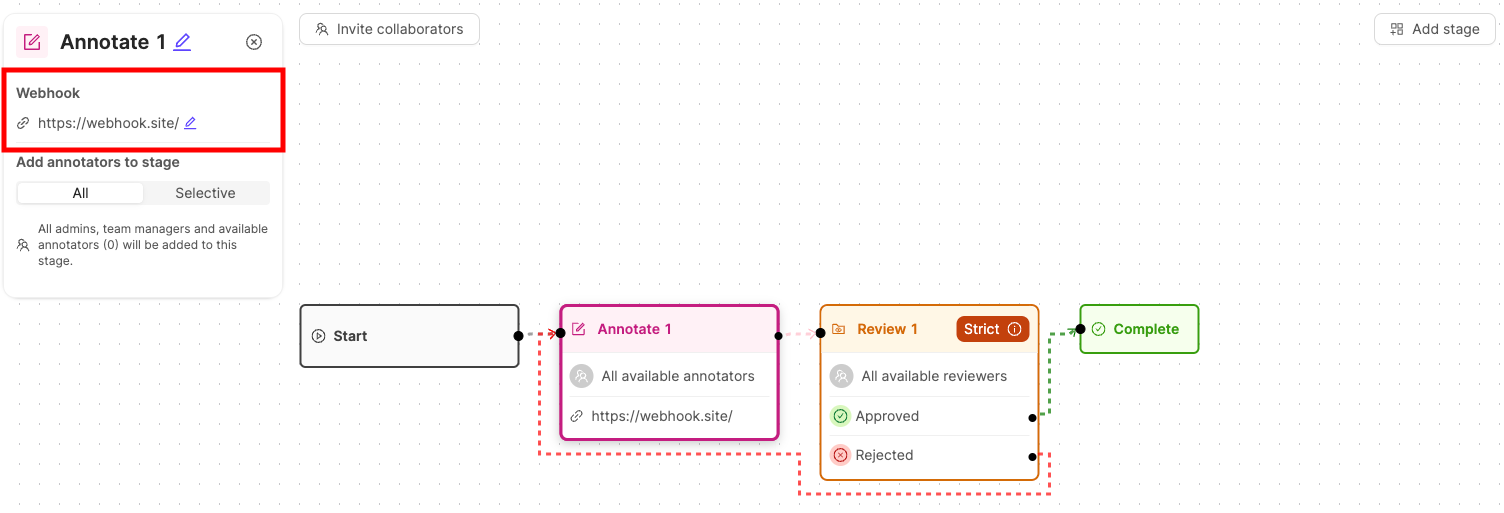Webhooks are automated requests that send a JSON payload with information about a Project or task to a specified URL at a designated point in your Project’s Workflow. For example, if a webhook is added to the Complete stage of a Project, then a JSON payload containing the Project and task ID is sent every time a task reaches the Complete stage.
Common use-cases for webhooks include:
Setting Up Webhooks
Webhooks can be set up when creating or editing a Workflow. This includes setting up a Workflow while creating a new annotation Project, creating a Workflow template, or editing the Workflow of an existing Project.
-
With the Workflow open, click the Workflow stage you want to create a webhook for.
A pop-up for to configure the Workflow stage appears.
-
In the pop-up, click the Edit symbol under the Webhook heading.
-
Enter the URL you want the JSON payload to be sent to. Press Enter on your keyboard to confirm.
- Ensure you save your changes.
Webhook Event Payloads
Task Submitted Payload
All task submitted events, triggered on the Annotate stage, have the following fields:
| Key | Type | Description |
|---|
uid | string | Unique identifier of the event. |
version | integer | Major version number to indicate backwards incompatible versions. |
source | string | The source of the payload. Is always “Encord”. |
event_type | string | The event type. task_submitted_event is triggered on the Annotate stage. |
event_created_timestamp | string | A string of the timestamp in the ISO 8601 format. For example 2022-04-13T14:35:11.791161+00:00. |
payload | object | An object containing the Project and label information. |
project_hash | string | The unique identifier for the Project. |
data_hashes | string | The unique identifiers for the data unit. |
label_hashes | string | The unique identifiers for the Label Row. |
{
"uid": "687457ce-6489-4891-b7c8-544477d99e41",
"version": 1,
"source": "Encord",
"event_type": "task_submitted_event",
"event_created_timestamp": "2024-03-25T15:18:55.406529+00:00",
"payload": {
"project_hash": "751a3a3e-46b6-4aad-b0b8-19b169f91266",
"data_hashes": [
"f0b012de-5aea-4457-b515-936b0c185771"
],
"label_hashes": [
"fdb9a21f-d9a7-48b5-9dac-dfe3e0e2c57f"
]
}
}
Task Completed Payload
All task submitted events, triggered on the Complete stage, have the following fields:
| Key | Type | Description |
|---|
uid | string | Unique identifier of the event. |
version | integer | Major version number to indicate backwards incompatible versions. |
source | string | The source of the payload. Is always “Encord”. |
event_type | string | The event type. task_submitted_event is triggered on the Annotate stage. |
event_created_timestamp | string | A string of the timestamp in the ISO 8601 format. For example 2022-04-13T14:35:11.791161+00:00. |
payload | object | An object containing the Project and label information. |
label_hash | string | The unique identifier for the Label Row. |
project_hash | string | The unique identifier for the Project. |
data_hash | string | The unique identifier for the data unit. |
{
"uid": "950f9048-bd28-42e7-89cb-2538f27c1695",
"version": 1,
"source": "Encord",
"event_type": "task_completed_event",
"event_created_timestamp": "2024-03-25T15:13:40.456441+00:00",
"payload": {
"label_hash": "c25be5c7-2a7f-4de9-8afd-9e2f72064e84",
"project_hash": "751a3a3e-46b6-4aad-b0b8-19b169f91266",
"data_hash": "f5fb9c39-cbfc-4bf3-8fdb-95ee4da24c14"
}
}
IP Addresses for Webhooks
For teams with advanced security practices, you must add our IP addresses to an approved list to ensure that only trusted traffic from our services can access your webhook endpoints.
US Deployment refers to customers working on Encord’s US-hosted instance, rather than simply being located in the United States.
34.89.106.119/3234.142.51.70/32
34.105.9.215/3234.168.169.190/32


